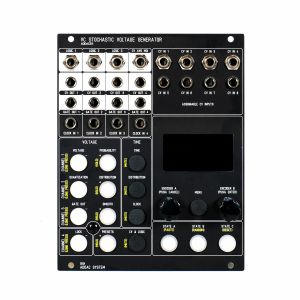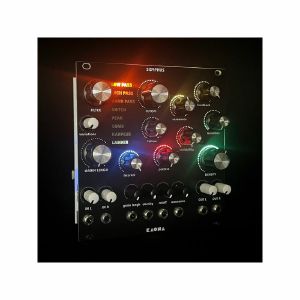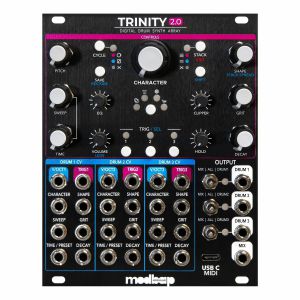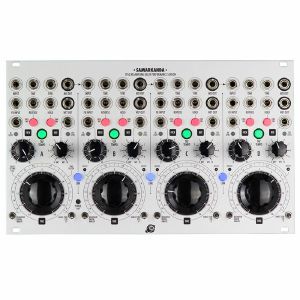Filter
Stock
Equipment
Format
Featured
Price
Tags
New releases last eight weeks: All genres
All genres vinyl released in the last four weeks
Items 1 to 4 of 4 on page 1 of 1
ADDAC System ADDAC511 VC Stochastic Voltage Generator Module (voltage generator synth module)
Cat: 1080319 Rel: 08 May 25
This is a fully fledged 4 channel voltage generator capable of all things random, with quantization, probability, distribution, interpolation, time control, clock, states and a 32 step sequencer
Notes: Based on the ADDAC501 Complex Random module, the 511 expands the concept to become an even more powerful random/stochastic voltage generator. Four channels, all capable of being used for envelopes, modulation sources, sequencers and much more.
Supplier's Notes:
This module greatly expands on the principles of the ADDAC501 Complex Random from 2013.
This is a fully fledged 4 channel voltage generator capable of all things random, with quantization, probability, distribution, interpolation, time control, clock, states and a 32 step sequencer.
The module operation relies on its screen for all parameter editing, each button accesses one single page where parameters can be changed allowing a fast and fluid workflow across all settings.
Long presses on all buttons have a secondary function allowing fast Channel selection plus Mute and Hold functions.
The combination of having 2 Encoders with Push buttons allow swift navigation and editing across all pages and their settings.
Tech Specs:
20HP
4.5cm deep
200mA +12V
100mA -12V
… Read moreSupplier's Notes:
This module greatly expands on the principles of the ADDAC501 Complex Random from 2013.
This is a fully fledged 4 channel voltage generator capable of all things random, with quantization, probability, distribution, interpolation, time control, clock, states and a 32 step sequencer.
The module operation relies on its screen for all parameter editing, each button accesses one single page where parameters can be changed allowing a fast and fluid workflow across all settings.
Long presses on all buttons have a secondary function allowing fast Channel selection plus Mute and Hold functions.
The combination of having 2 Encoders with Push buttons allow swift navigation and editing across all pages and their settings.
Tech Specs:
20HP
4.5cm deep
200mA +12V
100mA -12V
2 in stock $623.00
Click for better price!
or call +44 20 7424 1960
quote 1080319
quote 1080319
Kaona Sisyphus Multi-Filter/Multi-Grain Granular Filter Module (filter synth module)
Cat: 1072928 Rel: 24 Mar 25
Versatile granular filter that allows multiple grains in one audio stream
Notes: Super versatile granular filtering. Incoming sounds are granulated, then processed with eight contrasting filters. Hands-on and CV controls allow you to manipulate and modulate the output.
Supplier's Notes:
Sisyphus is built around a granular engine and a palette of eight original filters. Its granular system allows multiple grains to coexist within a single stereo audio stream, where they combine and interact with each other.
This filter is based on a comprehensive granular approach to sound: rather than a granular engine followed by a filter, it offers true integration of filtering into the grain-generation process. Each generated grain carries the filtering characteristics defined by the musician and will be combined with other grains according to evolving, configurable patterns.
These filters have been developed entirely from scratch in-house, without using typical filter libraries, so they each have their own unique color for you to explore!
Filters
Lowpass: Attenuates high frequencies above the cutoff frequency. 12 dB/oct slope.
Highpass: Attenuates low frequencies below the cutoff frequency. 12 dB/oct slope.
Bandpass: Lets through a band of frequencies around the cutoff frequency. 12 dB/oct slope.
Notch: Dips around the cutoff frequency while letting the rest of the spectrum pass through.
Peak: Boosts the band around the cutoff frequency while allowing the rest of the spectrum to pass without a drastic cut.
Comb: Creates a series of cancellations and resonances based on an internal delay and feedback.
Karplus (Karplus-Strong: Simulates the vibration of a string or looping resonance by combining a short delay, feedback, and damping.
Ladder: Inspired by Moog-style analogue filters, with four stages in cascade. Features a steep slope (24 dB/oct) and a distinctive resonance that can reach self-oscillation.
Filter Controls
Cutoff (Cutoff Frequency):Defines the filter's cutoff frequency or center frequency (depending on filter type), ranging from 10 Hz to 20 kHz.
Resonance: Emphasises frequencies near the cutoff frequency, from a slight bump up to the edge of self-oscillation.
Feedback: Re-injects part of the output back into the filter input.
Variations: Introduces an instability in the setting of the cutoff frequency, resonance, or feedback (depending on the selected filter), allowing for a more or less "organic" filter character.
Grain Controls: The incoming sound is continuously sampled and segmented into buffers. Each segment is analysed, filtered, and then extracted to become a grain. You can change the length of each grain, the interval between grains, the way grains follow one another, how they are arranged in relation to each other, and their density (number and influence).
Grain Length: Adjusts the length of the audio grains. The shorter the grains, the more the sound fragments into a "grained" granular texture; the longer the grains, the closer the result is to the original sound, but filtered and delayed. When multiple grains are played simultaneously, longer grains make echo effects more noticeable.
Grain Interval: Determines the time between the start of two successive grains (or the probability of automatic triggering).
Pattern: Grains are organized according to predefined, adjustable patterns. Several scenarios allow you to explore different ways grains can combine, from highly organized to more chaotic.
Density: Determines how many grains are played simultaneously and their intensity.
Variability: Sets the magnitude of the special effects specific to each pattern.
Transition: Defines the shape of the envelope applied to the grains as they link together.
Input and Output: Sisyphus works with two parallel channels that share the same settings. You can use it either in stereo mode or as two separate mono audio channels.
CV Inputs: Four CV inputs allow control of Sisyphus using other Eurorack modules. These inputs accept the standard Eurorack voltages (0 to 8 V).
The four basic parameters that can be controlled via CV are: Grain Length, Density, Cutoff, and Resonance.
However, you can configure the module differently using an external file on an SD card. In that case, any CV input can be assigned to any control, the input voltage range (from 1 to 8 V) can be set, LED brightness can be adjusted, and more.
Specifications
Width: 24 HP
Power Consumption:
+12 V: 200 mA
-12 V: 10 mA
+5 V: 0 mA
Depth: 28 mm
Carefully built in France, with all potentiometers bolted to the front panel, and shipped in a metal storage box.
Power cable and knurlies included.
… Read moreSupplier's Notes:
Sisyphus is built around a granular engine and a palette of eight original filters. Its granular system allows multiple grains to coexist within a single stereo audio stream, where they combine and interact with each other.
This filter is based on a comprehensive granular approach to sound: rather than a granular engine followed by a filter, it offers true integration of filtering into the grain-generation process. Each generated grain carries the filtering characteristics defined by the musician and will be combined with other grains according to evolving, configurable patterns.
These filters have been developed entirely from scratch in-house, without using typical filter libraries, so they each have their own unique color for you to explore!
Filters
Lowpass: Attenuates high frequencies above the cutoff frequency. 12 dB/oct slope.
Highpass: Attenuates low frequencies below the cutoff frequency. 12 dB/oct slope.
Bandpass: Lets through a band of frequencies around the cutoff frequency. 12 dB/oct slope.
Notch: Dips around the cutoff frequency while letting the rest of the spectrum pass through.
Peak: Boosts the band around the cutoff frequency while allowing the rest of the spectrum to pass without a drastic cut.
Comb: Creates a series of cancellations and resonances based on an internal delay and feedback.
Karplus (Karplus-Strong: Simulates the vibration of a string or looping resonance by combining a short delay, feedback, and damping.
Ladder: Inspired by Moog-style analogue filters, with four stages in cascade. Features a steep slope (24 dB/oct) and a distinctive resonance that can reach self-oscillation.
Filter Controls
Cutoff (Cutoff Frequency):Defines the filter's cutoff frequency or center frequency (depending on filter type), ranging from 10 Hz to 20 kHz.
Resonance: Emphasises frequencies near the cutoff frequency, from a slight bump up to the edge of self-oscillation.
Feedback: Re-injects part of the output back into the filter input.
Variations: Introduces an instability in the setting of the cutoff frequency, resonance, or feedback (depending on the selected filter), allowing for a more or less "organic" filter character.
Grain Controls: The incoming sound is continuously sampled and segmented into buffers. Each segment is analysed, filtered, and then extracted to become a grain. You can change the length of each grain, the interval between grains, the way grains follow one another, how they are arranged in relation to each other, and their density (number and influence).
Grain Length: Adjusts the length of the audio grains. The shorter the grains, the more the sound fragments into a "grained" granular texture; the longer the grains, the closer the result is to the original sound, but filtered and delayed. When multiple grains are played simultaneously, longer grains make echo effects more noticeable.
Grain Interval: Determines the time between the start of two successive grains (or the probability of automatic triggering).
Pattern: Grains are organized according to predefined, adjustable patterns. Several scenarios allow you to explore different ways grains can combine, from highly organized to more chaotic.
Density: Determines how many grains are played simultaneously and their intensity.
Variability: Sets the magnitude of the special effects specific to each pattern.
Transition: Defines the shape of the envelope applied to the grains as they link together.
Input and Output: Sisyphus works with two parallel channels that share the same settings. You can use it either in stereo mode or as two separate mono audio channels.
CV Inputs: Four CV inputs allow control of Sisyphus using other Eurorack modules. These inputs accept the standard Eurorack voltages (0 to 8 V).
The four basic parameters that can be controlled via CV are: Grain Length, Density, Cutoff, and Resonance.
However, you can configure the module differently using an external file on an SD card. In that case, any CV input can be assigned to any control, the input voltage range (from 1 to 8 V) can be set, LED brightness can be adjusted, and more.
Specifications
Width: 24 HP
Power Consumption:
+12 V: 200 mA
-12 V: 10 mA
+5 V: 0 mA
Depth: 28 mm
Carefully built in France, with all potentiometers bolted to the front panel, and shipped in a metal storage box.
Power cable and knurlies included.
2 in stock $570.98
Click for better price!
or call +44 20 7424 1960
quote 1072928
quote 1072928
Modbap Modular Trinity 2.0 Digital Drum Synth Array Module (drum synth module)
Cat: 1069660 Rel: 31 Mar 25
This compact 20HP design packs innovative features, such as six different drum synth algorithms - including the newly added ORB and CLANG - as well as enhanced connectivity and expanded control options
Notes: Modbap's three-voice drum module gets a major update, introducing new modal synthesis and metallic FM/RM algorithms, 12 customisable presets (four per channel), 12-pad finger drumming mode and much more. Super versatile.
Supplier's Notes:
Modbap Trinity 2.0 - Digital Drum Synth Array for Eurorack
Introducing Trinity 2.0, the updated and improved digital drum synth array eurorack module from Modbap Modular. This compact 20HP design packs innovative features, such as six different drum synth algorithms - including the newly added ORB and CLANG - as well as enhanced connectivity and expanded control options. Each of the three independent drum channels offers a wide range of sound design possibilities, with seven main controls for shaping tone, pitch, and texture, in addition to extensive CV and USB-C MIDI inputs.
Trinity 2.0 now incorporates advanced preset management, featuring 12 customizable presets (four per channel), a MIDI-based 12-pad finger drumming mode, and the capability to select presets via CV. Additionally, it retains its legacy features such as Cycle Modes (Round Robin and Random) and Stack Modes (layering two or three voices), providing infinite creative potential. With dimmable LEDs and USB-C connectivity, Trinity 2.0 caters to modular synth enthusiasts, hobbyists, beatmakers, and sound designers, offering a vast array of percussive textures and tonal possibilities. Compatible with both the original and refreshed hardware, Trinity 2.0 firmware elevates modular percussion to new levels of versatility. More than a module, Trinity is a powerful drum synth brain disguised as a Eurorack module.
Drum Synth Algorithms
BLOCK (Analogue Inspired): Drum synth building blocks featuring sine and triangle core. Great for traditional electronic drum creation.
HEAP (Additive): Additive drum synth with 8 partials. Great for fun natural sounds and pitched percussive sounds (i.e. bells, chimes, steel drums, and wood blocks etc.).
NEON (FM): FM drum synth engine. Great for high quality FM drums, clangourous metallic percussion and more.
ARCADE (Noise): Quirky noise generator synth, reminiscent of classic 1980's arcade games sounds - zaps, crashes, explosions etc. Great for claps, hats, even some vinyl noise approximations, and all sorts of fun percussive and degraded noises.
New with Trinity 2.0
Orb (Modal): Modal synthesis for resonant tonal percussion, ideal for creating rich, bell-like tones, tuned drums, and dynamic resonant textures. This algorithm excels in producing harmonic structures with natural decay, making it perfect for adding depth, warmth, and intricate timbres to rhythmic compositions.
Clang (Metallic FM / RM): Metallic FM/RM synthesis for bright, resonant cymbals and hi-hats, perfect for designing sharp, cutting high-frequency percussion. It is particularly suited for crafting hi-hats, cymbals, and other metallic percussion sounds with complex overtones and a crisp attack. It excels at producing metallic textures, chimes, and clangourous timbres with complex overtones.
Modes
Cycle Modes
The cycle modes can be enabled and disabled per channel.
'Round Robin' mode will switch between each drum synth type sequentially with each new trigger to the drum channel.
'Random' mode will generate a new random drum sound with each new trigger to the drum channel.
Stack Modes
The stack modes group the channels together allowing 2 or 3 drum channels to be triggered by the primary channel's trigger and v/oct inputs.
Stacked drums can be spread out similar to unison mode on a traditional synthesizer. Stack modes are inspired by the characteristics of chopped breaks where drums tend to overlap and fan out depending on the content of the chopped source material.
MIDI Finger Drumming Mode
MIDI Finger Drumming Mode allows control of drum voices and presets using an external MIDI pad controller connected via USB-C. It allows for triggering drum sounds with assigned MIDI notes via drum pads or keyboard controller. This mode enhances real-time performance and integrates seamlessly into MIDI-based music setups for dynamic, hands-on beatmaking and sound design.
This module features six drum algorithms utilizing various synthesis methods:
BLOCK: Classic drum synth using subtractive synthesis
HEAP: Additive drum synthesis with rich partials
NEON: Frequency modulation (FM) drum synth
ARCADE: Noise-based synthesis inspired by retro gaming sounds
ORB: Modal synthesis for resonant tonal percussion
CLANG: Metallic FM/RM synthesis for bright, resonant cymbals, hi-hats, and metallic percussion
Width: 20HP
Depth: 28mm
Power requirements: 153mA +12V, 7mA -12V (160mA peak on power-up)
… Read moreSupplier's Notes:
Modbap Trinity 2.0 - Digital Drum Synth Array for Eurorack
Introducing Trinity 2.0, the updated and improved digital drum synth array eurorack module from Modbap Modular. This compact 20HP design packs innovative features, such as six different drum synth algorithms - including the newly added ORB and CLANG - as well as enhanced connectivity and expanded control options. Each of the three independent drum channels offers a wide range of sound design possibilities, with seven main controls for shaping tone, pitch, and texture, in addition to extensive CV and USB-C MIDI inputs.
Trinity 2.0 now incorporates advanced preset management, featuring 12 customizable presets (four per channel), a MIDI-based 12-pad finger drumming mode, and the capability to select presets via CV. Additionally, it retains its legacy features such as Cycle Modes (Round Robin and Random) and Stack Modes (layering two or three voices), providing infinite creative potential. With dimmable LEDs and USB-C connectivity, Trinity 2.0 caters to modular synth enthusiasts, hobbyists, beatmakers, and sound designers, offering a vast array of percussive textures and tonal possibilities. Compatible with both the original and refreshed hardware, Trinity 2.0 firmware elevates modular percussion to new levels of versatility. More than a module, Trinity is a powerful drum synth brain disguised as a Eurorack module.
Drum Synth Algorithms
BLOCK (Analogue Inspired): Drum synth building blocks featuring sine and triangle core. Great for traditional electronic drum creation.
HEAP (Additive): Additive drum synth with 8 partials. Great for fun natural sounds and pitched percussive sounds (i.e. bells, chimes, steel drums, and wood blocks etc.).
NEON (FM): FM drum synth engine. Great for high quality FM drums, clangourous metallic percussion and more.
ARCADE (Noise): Quirky noise generator synth, reminiscent of classic 1980's arcade games sounds - zaps, crashes, explosions etc. Great for claps, hats, even some vinyl noise approximations, and all sorts of fun percussive and degraded noises.
New with Trinity 2.0
Orb (Modal): Modal synthesis for resonant tonal percussion, ideal for creating rich, bell-like tones, tuned drums, and dynamic resonant textures. This algorithm excels in producing harmonic structures with natural decay, making it perfect for adding depth, warmth, and intricate timbres to rhythmic compositions.
Clang (Metallic FM / RM): Metallic FM/RM synthesis for bright, resonant cymbals and hi-hats, perfect for designing sharp, cutting high-frequency percussion. It is particularly suited for crafting hi-hats, cymbals, and other metallic percussion sounds with complex overtones and a crisp attack. It excels at producing metallic textures, chimes, and clangourous timbres with complex overtones.
Modes
Cycle Modes
The cycle modes can be enabled and disabled per channel.
'Round Robin' mode will switch between each drum synth type sequentially with each new trigger to the drum channel.
'Random' mode will generate a new random drum sound with each new trigger to the drum channel.
Stack Modes
The stack modes group the channels together allowing 2 or 3 drum channels to be triggered by the primary channel's trigger and v/oct inputs.
Stacked drums can be spread out similar to unison mode on a traditional synthesizer. Stack modes are inspired by the characteristics of chopped breaks where drums tend to overlap and fan out depending on the content of the chopped source material.
MIDI Finger Drumming Mode
MIDI Finger Drumming Mode allows control of drum voices and presets using an external MIDI pad controller connected via USB-C. It allows for triggering drum sounds with assigned MIDI notes via drum pads or keyboard controller. This mode enhances real-time performance and integrates seamlessly into MIDI-based music setups for dynamic, hands-on beatmaking and sound design.
This module features six drum algorithms utilizing various synthesis methods:
BLOCK: Classic drum synth using subtractive synthesis
HEAP: Additive drum synthesis with rich partials
NEON: Frequency modulation (FM) drum synth
ARCADE: Noise-based synthesis inspired by retro gaming sounds
ORB: Modal synthesis for resonant tonal percussion
CLANG: Metallic FM/RM synthesis for bright, resonant cymbals, hi-hats, and metallic percussion
Width: 20HP
Depth: 28mm
Power requirements: 153mA +12V, 7mA -12V (160mA peak on power-up)
1 in stock $598.66
Click for better price!
or call +44 20 7424 1960
quote 1069660
quote 1069660
Xaoc Devices Samarkanda 1953 Resampling Delay Performance Station Module (effect synth module)
Cat: 1079380 Rel: 27 Mar 25
A high versatile digital quad delay module.
Notes: A super impressive offering from Xaoc, the Samarkanda is a quad delay module designed for hands-on, real-time performance. Dial in everything from loops to stereo delays, resonators, modulation effects and much more.
Supplier's Notes:
Xaoc Devices Samarkanda is a digital quad delay module with extensive patching capabilities and a lot of flexibility for signal mangling. It can be used as four entirely independent delays, a dual stereo delay, a complex/multi-tap or multi-channel delay, a quad/polyphonic resonator, dual chorus, dual flanger, reverb, looper (with sound on sound!), and granulator, or any combination of those. You can reverse the delayed signal, hold it, squeeze and stretch it beyond all recognition and still go back to the original piece of audio captured in the buffer! The internal lossless normalization (the signal doesn't leave the digital domain) combined with top-notch components (including 24-bit AKM converters and 32-bit internal processing) are responsible for high sound quality. Samarkanda has been conceived in the truly modular spirit. Not only can you control almost all its features remotely with CV/gates, but the external feedback path gives you the opportunity to process the delayed signal with other modules.
Samarkanda offers a wide range of delay times beginning at a mere 0.5ms and reaching up to 15 seconds per channel. That means that, by stacking its four channels, you can achieve up to one minute delay! There are two operating modes switchable individually for each channel. Analogue delivers pitch changes that resemble classic analogue tape and BBD delays. When you combine it with the looping Hold function, you can play Samarkanda with any 1V/octave CV source. By using the Sync function you can even loop single wave cycles. The Digital mode gives you a granular buffer-scrubbing effect (no pitch change) across the whole delay time range. You can seamlessly switch back and forth between modes without losing any information. You can use Samarkanda for multiple tasks at the same time - from four independent delay lines through any combination of channels processing the same signal up to a quad behemoth. You can also use the linking feature for ease of operation (the first channel in the chain acts as the main control source for the others).
As most settings operate on a per-channel basis, you can freely combine different features (such as analog/digital behaviour, delay time range, reverse and hold functions, etc.) in a configuration of your choosing. You can synchronize each of its channels separately to a different source, either via the Sync input, or by using the tap-tempo functionality (with multiplication and division galore). Should you ever get lost, the Purge button comes in handy when/if things start to spiral out of control!
… Read moreSupplier's Notes:
Xaoc Devices Samarkanda is a digital quad delay module with extensive patching capabilities and a lot of flexibility for signal mangling. It can be used as four entirely independent delays, a dual stereo delay, a complex/multi-tap or multi-channel delay, a quad/polyphonic resonator, dual chorus, dual flanger, reverb, looper (with sound on sound!), and granulator, or any combination of those. You can reverse the delayed signal, hold it, squeeze and stretch it beyond all recognition and still go back to the original piece of audio captured in the buffer! The internal lossless normalization (the signal doesn't leave the digital domain) combined with top-notch components (including 24-bit AKM converters and 32-bit internal processing) are responsible for high sound quality. Samarkanda has been conceived in the truly modular spirit. Not only can you control almost all its features remotely with CV/gates, but the external feedback path gives you the opportunity to process the delayed signal with other modules.
Samarkanda offers a wide range of delay times beginning at a mere 0.5ms and reaching up to 15 seconds per channel. That means that, by stacking its four channels, you can achieve up to one minute delay! There are two operating modes switchable individually for each channel. Analogue delivers pitch changes that resemble classic analogue tape and BBD delays. When you combine it with the looping Hold function, you can play Samarkanda with any 1V/octave CV source. By using the Sync function you can even loop single wave cycles. The Digital mode gives you a granular buffer-scrubbing effect (no pitch change) across the whole delay time range. You can seamlessly switch back and forth between modes without losing any information. You can use Samarkanda for multiple tasks at the same time - from four independent delay lines through any combination of channels processing the same signal up to a quad behemoth. You can also use the linking feature for ease of operation (the first channel in the chain acts as the main control source for the others).
As most settings operate on a per-channel basis, you can freely combine different features (such as analog/digital behaviour, delay time range, reverse and hold functions, etc.) in a configuration of your choosing. You can synchronize each of its channels separately to a different source, either via the Sync input, or by using the tap-tempo functionality (with multiplication and division galore). Should you ever get lost, the Purge button comes in handy when/if things start to spiral out of control!
4 in stock $588.70
Items 1 to 4 of 4 on page 1 of 1

 USD
USD









